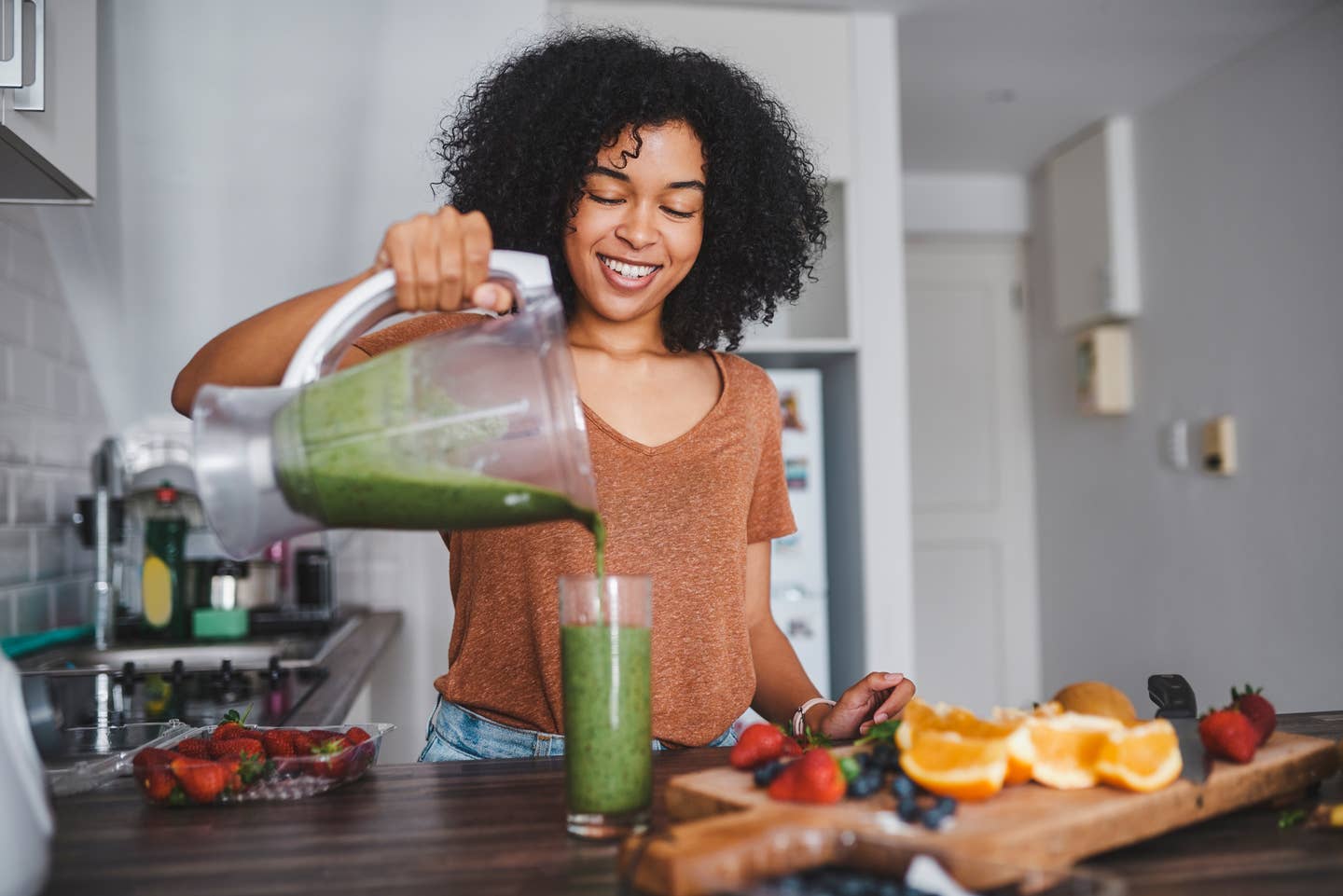
7 Simple Superfoods to Eat Daily for Optimal Health, From Nutritionists
We have all been trying to eat healthier this winter, but often times it can seem like a complicated order. How to get our nutrients, vitamins, and minerals that will help our bodies fight off infection, lower inflammation, feel more energetic and support a healthy immune system feels like a chemistry test at times. While loading up on plenty of plant-based foods every day to be our healthiest is a great way to start, eating healthy every day can be much, much simpler than we think, nutritionists say.
You don't have to chomp on raw garlic or pop a collection of supplements to enjoy optimal health. Simply add any of these everyday simple superfoods to your plate or snacking routine (or sipping habit) to strengthen immune function, lower inflammation, and have more energy.
These plant-based nutritionists are more than happy to share the foods that they eat daily, that are brimming with nutrition like vitamins and minerals, antioxidants, and gut-healthy probiotics that will help to bolster immune function and overall wellbeing, yet are totally realistic to eat daily. Read on–and when you shop next, don't skip the bell peppers.
1. Nuts for Immune Health
Morgyn Clair, MS, RDN, with Sprint Kitchen, tries to eat at least one serving of nuts almost daily. “According to a lot of recent research, many people, and especially vegans and vegetarians, do not get enough omega-3 fatty acids in their diet. Omega 3 is critical for immune health. One daily serving of at least one ounce of nuts is a great way to support immune health,” she says, noting this study which found a positive relationship between omega-3 fatty acid consumption and a healthy microbiome that is able to fight off infection better than the control group.
To keep things interesting and ensure a mix of different nutrients, Clair mixes things up by rotating between almonds, walnuts, and pistachios.
2. Kimchi for Gut Health
Bring on the fermented foods. Brooke Alpert MS, RD, CDN, author of The Sugar Detox, and medical advisor to Cure Hydration shares that kimchi — which refers to a wide range of salted and fermented veggies in Korean cuisine — has always been something she enjoyed, but since she’s home more these days, she’s been able to incorporate it as a consistent part of her eating habits. “I love to throw spicy kimchi in a salad or to mix it with rice, which has become a lunchtime staple here since the winter when salads became a bit less interesting,” she offers. “Kimchi is very high in fiber and filled with healthy probiotics, specifically the Lactobacillus bacteria, which can help boost your immune system, making it the perfect pandemic meal addition.”
3. Spinach for Immunity and to Fight Inflammation
“Spinach is a powerhouse food for the immune system because it is loaded with vitamin C and many antioxidants,” explains Allison Gregg, RDN, LD/N, Nutritional Consultant at Mom Loves Best. “A recent study in Nutrients found that vitamin C has a high anti-inflammatory and antioxidant capacity. These two properties reduce inflammation and oxidative stress which strengthens the immune system,” she continues.
If you’re not the biggest spinach fan, try slipping a handful or two of the leafy green into your favorite smoothie recipe, you’ll hardly detect a difference in taste and still reap the same nutritional benefits.
4. Raw Bell Peppers for Immunity and Iron Absortion
“Bell peppers are packed full of nutrients that benefit the body in significant ways, yet most of the general public is unaware of how healthy they actually are, until recently. Bell peppers are brimming with vitamin C, but this is its most vulnerable nutrient because it is denatured in the cooking process,” says Trista K. Best, MPH, RD, LDN at Balance One Supplements (hence her rec to eat bell peppers raw).
“Vitamin C has immune support benefits, but also improves the absorption of iron,” she adds, another essential nutrient your body needs, and one that can be harder to obtain on a plant-based diet. (For more on how to get enough iron when you’re following a plant-based diet, read our article here.
5. Green Tea for Weight Loss, Gut Health and Cardiovascular Health
“Green tea contains flavonoids and epigallocatechin gallate, EGCG, which are two powerful antioxidants,” says Gregg. “Compared to black tea, green tea is not fermented which preserves its EGCG content,” she adds, noting that EGCG has been studied for its ability to enhance immune function. For more on green tea and EGCG, check out our article on immune-boosting foods and supplements here.
Not enamored of green tea? Honestly, drinking other kinds of tea on a daily is a great idea to help in realms like burning fat, improving gut health, reducing cardiovascular risk and more.
6. Water for Overall Cell Function and Immunity Boosting
Not exactly a food, we know, but you can’t underestimate the importance of H2O. “Hydration has always been really important to me for mine and my patients' optimal health and a healthy immune system. When the pandemic first started, I noticed many of my patients and [I] were having a tough time keeping up with their water intake,” shares Alpert. “Maybe this was from being less active or perhaps since many of them weren't leaving their homes, there were missed chances to remember to drink more water,” she says, who in her role with Cure Hydration has also personally started enjoying the vegan, no-sugar-added flavor packets to her water. “It helps make water more interesting to drink and even better, helps to keep everyone properly hydrated with electrolytes which can support their immune system,” she adds.
7. Citrus Fruits for Immunity, Treat Respiratory Infection and Lower Inflammation
Melissa Nieves, RD at Kemtai, a digital home fitness company, is a big proponent of regular consumption of citrus fruits like oranges, grapefruits, and lemon. “They're not only refreshing and delicious, but they're also high in vitamin C. Vitamin C appears to be able to both prevent and treat respiratory and systemic infections by enhancing various immune cell functions,” she offers.
“As this paper from Nutrients states, ‘prevention of infection requires dietary vitamin C intakes that provide at least adequate, if not saturating plasma levels (i.e., 100–200 mg per day), which optimize cell and tissue levels,’” she elaborates, further noting that the Recommended Dietary Allowance (RDA) for adults for vitamin C is set at 75 mg/day for females and 90 mg/day for males.
Take note: Nieves recommends staying within the RDA parameters for healthy people, but in some cases, under medical supervision, more amounts can be beneficial depending on the medical condition to be treated.
Make it a point to include orange or clementine segments into a salad or to eat as a snack at least once a day and sip on lemon- or lime-infused water throughout the day.
8. Legumes
Best is a big proponent of legumes — beans, peas, and lentils — because their fiber keeps her feeling full long after a meal and they are also beneficial for feeding the gut's good bacteria. “It does this by binding and flushing out toxins and waste from your body, and even helps to reduce cholesterol and body weight,” shares Best. “Removing these toxins and waste and improving the gut's microbiome will all work together to improve gut health.”
On that note, we’re off to whip up a chili tonight. Raw bell peppers sprinkled on top.
Top 10 Sources of Plant-Based Protein According to a Nutritionist
1. Seitan
Protein: 21 grams in ⅓ cup (1 ounce) Seitan isn’t as popular as other proteins, but it should be! Made from wheat gluten, its texture resembles ground meat. It’s often used in pre-made veggie burgers or meatless nuggets. Seitan has a savory taste, like mushrooms or chicken, so it works well in dishes that call for an umami flavor. With a hearty texture, seitan can be the star of practically any vegan main dish. Add it to stir-fries, sandwiches, burritos, burgers, or stews. Like tofu, seitan will take on the flavor of any marinade or sauce.
2. Tempeh
Protein: 16 grams in 3 ounces If you like a protein with a bit of bite, add tempeh to your list. Made from fermented soybeans, tempeh has a slightly nutty flavor and is pressed into a block. Most varieties include some sort of grains, such as barley or millet. Not only is tempeh a plant-based source of protein, but the fermentation process also creates good-for-your-gut probiotics. You can cut tempeh right off the block and use it as the base for a sandwich or pan-fry it with some sauce. Or, crumble, heat, and make it the star of your next taco night.
3. Lentils
Protein: 13 grams in ½ cup cooked Lentils come in multiple varieties--red, yellow, green, brown, black. Regardless of the type lentils are small but mighty nutritional powerhouses. They pack a good amount of protein as well as iron, folate, and fiber. When cooked, brown lentils retain their texture and can be the base for a grain bowl or make a hearty substitute for ground meat in meatballs, lasagna, tacos or Bolognese. Red lentils are a bit softer and make a nice add-in for a hearty soup, chili, or stew.
4. Hemp Seeds
Protein: 10 grams in 3 tablespoons Hemp seeds are a tender and nutty seed, derived from the hemp plant. They contain good amounts of omega-3s, iron, folate, magnesium, phosphorus, and manganese. They are also a solid source of both soluble and insoluble fiber, which helps to keep your digestive tract healthy and humming. Because they pack a double whammy of protein and healthy fats, hemp seeds can help satisfy hunger, preventing those embarrassing stomach growls as you slog your way to your lunch break. Add them to your morning smoothie or sprinkle them on top of yogurt, oatmeal, or even a salad.
5. Tofu
Protein: 9 grams in 3 ounces (⅕ of a block) Made from coagulated soybeans, tofu is the most popular plant-based protein. Soy is one of the only meatless "complete" proteins, meaning that it contains all of the essential amino acids that the body can’t make but needs for muscle and immune function. With 15% of your daily calcium needs, tofu is also a good replacement for dairy.
6. Edamame
Protein: 9 grams of protein in ½ cup This sushi appetizer is a nutrient powerhouse, so eat it anytime. Edamame is really just another name for soybeans in their pods. Let’s list off some stats--a small ½-cup serving of edamame has 9 grams of protein, 15% of your daily vitamin C, 10% of your daily iron and 16% of your daily fiber. Keep a bag of edamame in your freezer to serve as a fun-to-eat side dish or opt for the shelled variety to toss into salads or a grain bowl.
7. Quinoa
Protein: 8 grams per cup (cooked) Quinoa is an ancient grain and since it's gluten-free a great choice for anyone avoiding gluten. Add it to your burger recipe to create filling texture, or instead of meat in your taco or burrito. Quinoa is among the healthiest foods on the planet, delivering phytonutrients that have anti-inflammatory qualities, so keep it in your pantry for any meal that needs a filling grain. Just remember to soak it and rinse before cooking to get rid of any bitter taste.
8. Black Beans
Protein: 7 grams in ½ cup (canned) Eating beans on the regular might as well be a prerequisite for a plant-based diet. Not only are canned black beans inexpensive, but they also contribute 10% of your daily iron and 25% of your daily fiber to your diet. For less than $1 a can, beans can be the star of tacos, quesadillas, salads, soups, burgers, or dips.
9. Amaranth
Protein: 6 grams in ⅔ cup (cooked) Chances are you’ve never cooked amaranth. But you should, since this tiny, gluten- free grain is packed with almost 30% of your daily fiber and 20% of your daily iron. Cook it like a traditional grain to yield a soft, porridge-like texture. Many people add amaranth to other a hot breakfast cereal mixture, like oats and quinoa. It also pops like popcorn. Toss it in a pot with some oil and wait for it to pop up into a nutritious snack.
10. Peas
Protein: 5 grams in ⅔ cup If peas were one of your most hated veggies as a kid, it’s time to give them another chance. These green beans are a great low-calorie protein to keep in your freezer. Sure, they don’t always taste great when steamed or microwaved (who wants to eat mushy, overcooked peas?), but they do blend well into a yummy puree that can be slathered on toast. To amp up the flavor, add some lemon juice or mint to your mix before you blend.
More From The Beet






